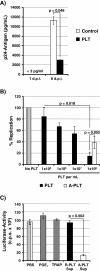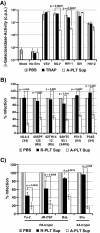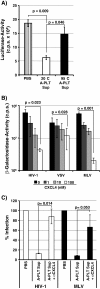Platelet activation suppresses HIV-1 infection of T cells
- PMID: 23634812
- PMCID: PMC3660175
- DOI: 10.1186/1742-4690-10-48
Platelet activation suppresses HIV-1 infection of T cells
Abstract
Background: Platelets, anucleate cell fragments abundant in human blood, can capture HIV-1 and platelet counts have been associated with viral load and disease progression. However, the impact of platelets on HIV-1 infection of T cells is unclear.
Results: We found that platelets suppress HIV-1 spread in co-cultured T cells in a concentration-dependent manner. Platelets containing granules inhibited HIV-1 spread in T cells more efficiently than degranulated platelets, indicating that the granule content might exert antiviral activity. Indeed, supernatants from activated and thus degranulated platelets suppressed HIV-1 infection. Infection was inhibited at the stage of host cell entry and inhibition was independent of the viral strain or coreceptor tropism. In contrast, blockade of HIV-2 and SIV entry was less efficient. The chemokine CXCL4, a major component of platelet granules, blocked HIV-1 entry and neutralization of CXCL4 in platelet supernatants largely abrogated their anti-HIV-1 activity.
Conclusions: Release of CXCL4 by activated platelets inhibits HIV-1 infection of adjacent T cells at the stage of virus entry. The inhibitory activity of platelet-derived CXCL4 suggests a role of platelets in the defense against infection by HIV-1 and potentially other pathogens.
Figures




Similar articles
-
Identification of the platelet-derived chemokine CXCL4/PF-4 as a broad-spectrum HIV-1 inhibitor.Proc Natl Acad Sci U S A. 2012 Jun 12;109(24):9569-74. doi: 10.1073/pnas.1207314109. Epub 2012 May 29. Proc Natl Acad Sci U S A. 2012. PMID: 22645343 Free PMC article.
-
Platelet factor 4 (CXCL4) facilitates human macrophage infection with HIV-1 and potentiates virus replication.Innate Immun. 2009 Dec;15(6):368-79. doi: 10.1177/1753425909106171. Innate Immun. 2009. PMID: 19773294
-
HIV Exploits Antiviral Host Innate GCN2-ATF4 Signaling for Establishing Viral Replication Early in Infection.mBio. 2017 May 2;8(3):e01518-16. doi: 10.1128/mBio.01518-16. mBio. 2017. PMID: 28465428 Free PMC article.
-
Human Immunodeficiency Virus Type 1 Cellular Entry and Exit in the T Lymphocytic and Monocytic Compartments: Mechanisms and Target Opportunities During Viral Disease.Adv Virus Res. 2015;93:257-311. doi: 10.1016/bs.aivir.2015.04.001. Epub 2015 May 8. Adv Virus Res. 2015. PMID: 26111588 Review.
-
Role of Platelet Cytokines in Dengue Virus Infection.Front Cell Infect Microbiol. 2020 Sep 30;10:561366. doi: 10.3389/fcimb.2020.561366. eCollection 2020. Front Cell Infect Microbiol. 2020. PMID: 33102253 Free PMC article. Review.
Cited by
-
Platelets: essential components of the immune system.Curr Trends Immunol. 2015;16:65-78. Curr Trends Immunol. 2015. PMID: 27818580 Free PMC article.
-
Adenosine signaling and adenosine deaminase regulation of immune responses: impact on the immunopathogenesis of HIV infection.Purinergic Signal. 2018 Dec;14(4):309-320. doi: 10.1007/s11302-018-9619-2. Epub 2018 Aug 10. Purinergic Signal. 2018. PMID: 30097807 Free PMC article. Review.
-
Human blood platelets and viruses: defense mechanism and role in the removal of viral pathogens.Thromb J. 2018 Jul 17;16:16. doi: 10.1186/s12959-018-0170-8. eCollection 2018. Thromb J. 2018. PMID: 30026673 Free PMC article. Review.
-
Brief report: Circulating markers of fibrosis are associated with immune reconstitution status in HIV-infected men.PLoS One. 2018 Jan 30;13(1):e0191606. doi: 10.1371/journal.pone.0191606. eCollection 2018. PLoS One. 2018. PMID: 29381717 Free PMC article.
-
Revisiting a quarter of a century of simian immunodeficiency virus (SIV)-associated cardiovascular diseases at the German Primate Center.Primate Biol. 2017 Jun 12;4(1):107-115. doi: 10.5194/pb-4-107-2017. eCollection 2017. Primate Biol. 2017. PMID: 32110698 Free PMC article.
References
-
- AIDS epidemic update 2009. http://www.unaids.org.
-
- Geijtenbeek TB, Kwon DS, Torensma R, van Vliet SJ, van Duijnhoven GC, Middel J, Cornelissen IL, Nottet HS, KewalRamani VN, Littman DR. DC-SIGN, a dendritic cell-specific HIV-1-binding protein that enhances trans-infection of T cells. Cell. 2000;100:587–597. doi: 10.1016/S0092-8674(00)80694-7. - DOI - PubMed
-
- van Montfort T, Nabatov AA, Geijtenbeek TB, Pollakis G, Paxton WA. Efficient capture of antibody neutralized HIV-1 by cells expressing DC-SIGN and transfer to CD4+ T lymphocytes. J Immunol. 2007;178:3177–3185. - PubMed
Publication types
MeSH terms
Substances
LinkOut - more resources
Full Text Sources
Other Literature Sources
Medical
Miscellaneous

